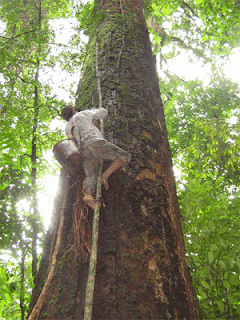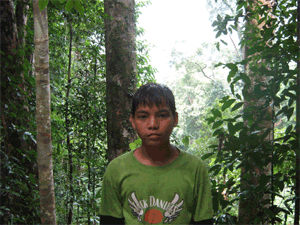Borneo Rain Forest blog!
Welcome to Borneo Rain Forest blog site! This site dedicated to support our independent reforest project - "Borneo Reforest Project".

Borneo Reforest Project is a nonprofit tree-planting foundation dedicated to properly planting, maintaining and protecting as many indigenous trees as possible Borneo Island.
We work with businesses, schools, organizations, municipalities, entertainers and individuals to coordinate tree-planting events throughout the Borneo and abroad.
For every US Dollar you contribute, an indigneous tree is planted in a non-harvest location that you select from our reforest list of sites.
For contributions via Credit Card or PayPal please click on the 'Make a Donation' link below:
Make a Donation
WHY ARE BORNEO REFOREST PROJECT LOCATED IN SOUTH BORNEO?
 South Borneo, Indonesia is one of the best places in the world to plant rain forest trees. It has an excellent rainy season, superb fertile soil and rain forest trees here grow very fast and very thick. A rain forest tree planted here will absorb far more carbon than a tree planted in the US or Europe.
South Borneo, Indonesia is one of the best places in the world to plant rain forest trees. It has an excellent rainy season, superb fertile soil and rain forest trees here grow very fast and very thick. A rain forest tree planted here will absorb far more carbon than a tree planted in the US or Europe.
Another reason is: this is an ideal place to begin the reforestation process. The deforested areas of South East Asia cannot be reforested easily. The ground is completely stripped of nutrients due to erosion. Indonesia can be reforested and the political will and labor is here to do it. Owe plan to continue with Indonesia as our headquarters and spread our reforestation to neighboring states on Borneo such as East Borneo and Center Borneo and eventually West Borneo - Indonesia.
HOW MANY RAIN FOREST TREES ARE TYPICALLY PLANTED IN A REFORESTATION PROJECT?
 Larger reforestation projects start at 200 hectares (there are 2.47 acres/hectare). Approximately 200,000 saplings are planted (1,000 per hectare average) depending on the rain forest specie(s) of tree selected. Blocks of 10, 20 or 50 hectares will be planted in stages. These plantations will be handled by forest engineer/specialists so that they produce wood, fix carbon and release oxygen to the atmosphere.
Larger reforestation projects start at 200 hectares (there are 2.47 acres/hectare). Approximately 200,000 saplings are planted (1,000 per hectare average) depending on the rain forest specie(s) of tree selected. Blocks of 10, 20 or 50 hectares will be planted in stages. These plantations will be handled by forest engineer/specialists so that they produce wood, fix carbon and release oxygen to the atmosphere.
The forest plantations begin with 1,000 rain forest trees per hectare, and little by little we glean slow growing and weak tropical rain forest trees until all that are left are those that grow best and will accumulate more carbon in their trunks, branches, foliage and root system.
At the end of the gleaning/production cycle, there are around 200 to 300 rain forest trees per hectare, each having a diameter between 35 to 50 cm (approx 14-20 inches) and a height of around 25 to 30 meters (approx 80 - 100 feet). Note: the growth dimensions are simply estimates and will depend on the species of tree selected for planting.
Some rain forest trees grow more quickly than others, but all fix carbon and release oxygen to the atmosphere. Each one of these large rain forest trees has the capacity to clean up to one ton of CO2 during 20 years of its life. Therefore, each seeded hectare of rain forest trees can clean, at least, 200-300 tons of CO2. If the project is 200 hectares, the removed CO2 of the atmosphere will be of 40,000 to 60,000 tons over the life of the project (20 years).
Smaller projects for children’s education or for protected areas may include very small amounts of rain forest trees for planting. Also, the age of the tree may vary depending on the application. For example: if we are planting rain forest trees to shore up a riverbank, we may elect to use more mature rain forest trees that have a better chance of survival and will take root more quickly. In cases where we are planting rain forest trees to restore lost animal habitats, we may choose many different species related to what wildlife in that area will require for survival. We often plant wild rain forest trees to attract the large of wild birds, deer, monkey, reptile, and more back to traditional feeding areas where farmers may have illegally cut them down.
DO BORNEO REFOREST PROJECT DO ALL THE PLANTING ITSELVES?
 No. It would be very inefficient (and a poor use of your money) for your Foundation to hire so many employees to do this work. There are a number of organizations in South Borneo - Indonesia, who do reforestation activities and we typically use planting services, while providing the technical expertise to ensure our tree plantations have a high survival rate. Basically we cooperate with local community to build a nursery which will support our rain forest trees plant. And we also shop from local community for the best quality trees and planters for the best price we can get.
No. It would be very inefficient (and a poor use of your money) for your Foundation to hire so many employees to do this work. There are a number of organizations in South Borneo - Indonesia, who do reforestation activities and we typically use planting services, while providing the technical expertise to ensure our tree plantations have a high survival rate. Basically we cooperate with local community to build a nursery which will support our rain forest trees plant. And we also shop from local community for the best quality trees and planters for the best price we can get.
CAN I VOLUNTEER TO HELP BORNEO REFOREST PROJECT IN SOME WAY?
Yes. There are ways everyone can help us in spreading the word about Carbon Neutrality. Here are a few ways you can help our organization.
1) If you have a specific skill you believe would be of value to our project (we often need forest engineers, biologists, web developers, journalists, marketing executives and other skilled persons to help us in our development), please send us an email. We also have a classified ads page where you contribute us with be a paid ads member. Every penny you pay for an classified ads on our site will be used for our rain forest tress planting project. Please feel free to browse this and see a classified ad space you needs. If you are physically fit and would like a working holiday in South Borneo, Indonesia, we encourage you to consider working with BRPV (the Borneo Reforest Project Volunteer's).They care for the Rain Forest Trees habitats here in Borneo, supplementing the limited resources of the government. They protect the endemic of rain forest trees species here in Borne, help fight forest fires, stop deforestations, join in nursery activities and do many other necessary things within the beautiful rain forest trees habitats of Borneo. We actively support BRPV due to their role as protectors of the old growth forests. They have been instrumental in stopping the illegal poaching of timber in the remote forest areas.
2) If you have a web site and would like to help direct traffic to us, please link to us by place our website tag link below on your site: " Borneo Reforest Project!Plant a rain forest tree today. Tropical rain forest trees will capture 496lbs Carbon and free 1,311 of Oxygen! "
 3) If you become Carbon Neutral, why not add the “I’m Carbon Neutral” logo to your emails with a link to our site? This will let all your friends know what you’ve done and encourage them to start thinking about Carbon Neutrality.
3) If you become Carbon Neutral, why not add the “I’m Carbon Neutral” logo to your emails with a link to our site? This will let all your friends know what you’ve done and encourage them to start thinking about Carbon Neutrality.
4) If your company has an email newsletter, why not mention our rain forest trees planting project? We appreciate a word or two about what we’re doing from any reliable source. The more persons who know about Carbon Neutrality and plant Borneo rain forest trees or save Borneo forested areas, the better off we all are.
5) Does your business send out lots of invoices or printed materials? Why not add the “Carbon Neutrality” logo? You could be responsible for people planting thousands of Borneo rain forest trees or educating hundreds of children. Or you can contribute fund (US 50cent/each) by reprint and resell our "Shorea Newsletter" to your subscriber.
When explicit application guidelines are published by the foundation, carefully follow the instructions. If outlines or a series of questions are provided, follow the indicated order, answer each section, and avoid evasive language.








